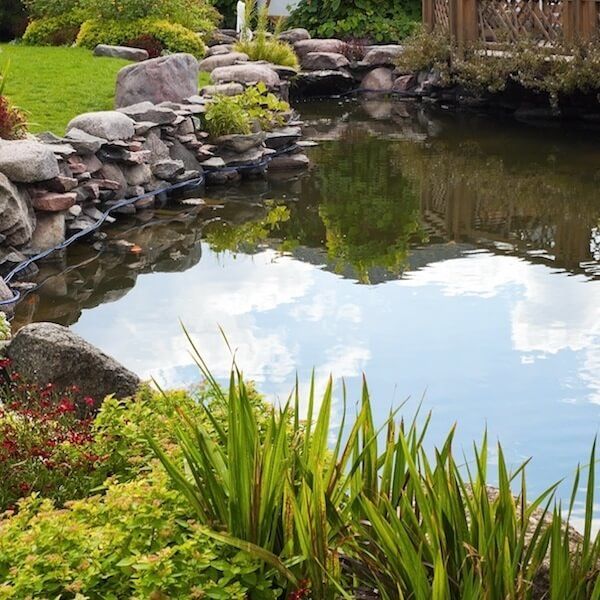Goldfish Pond Filter
Filtration
A pond filter is an important component to a healthy goldfish pond. Most filters are labeled in terms of maximum volume of pond water and be aware that when selecting a pond filter, filter performance is based on having a low stock and a strict feeding regiment. In warmer climates a larger than required filter is also usually needed. To be on the safe side, you might want to buy a pond filter one size up.
Run your pond filter 24/7 to keep all the beneficial bacteria alive since they need good oxygenated water circulation to survive. If your pond filter does stop, drain it first to eliminate any dead bacteria before turning it back on.

Mechanical Filtration
There are three types of pond filtration: mechanical, chemical and biological.
Mechanical Filtration uses a mechanical pump to push or pull the water in your goldfish pond through the various filter media in your pond filter. The dirty pond water is cleaned when it passes through the filter media which collects and traps the large and small impurities in that water. The filtered pond water is then reintroduced into the goldfish pond.
Chemical Filtration uses a mechanical filter but the filter media used contain chemicals that help remove impurities.
Biological Filtration: uses beneficial aerobic bacteria that grow in a pond filter or in a substrate bottom. These beneficial bacteria turn goldfish ammonia waste into nitrite and then into nitrate. Aquatic plants then use the nitrate as plant food which encourages plant growth. See the Nitrogen Cycle for more info.
Filter Media
- Filter Brushes: Cylinder shaped with bristles that are durable, easy to clean and catch the large particles.
- Filter Gravel: Inexpensive with a reasonable amount of surface area.
- Filter Foam: Light weight and very easy to use.
- Clay Granules: Lighter and more surface area than gravel.
- Plastic Tubes and Balls: Allow good water flow while catching the larger particles.
- Aquarock: An ideal biological filter with a porous and a large surface area.
- Filtroc: An ideal biological filter with a large surface area.
- Filter Matting: Easy to maintain and works well as a biological and mechanical filter
- Zeolite: A chemical filter media that absorbs impurities.
- Activated Carbon: A chemical filter media that absorbs impurities.

Types of Pond Filters
A basic pond filter consists of sponge filter media that can be placed inside a pond pump. This type of filter is good for a small goldfish pond of a few hundred liters that is stocked with only a handful of goldfish. These basic pond filters will catch particles and help keep them from clogging your ponds waterfall or fountain. Its effectiveness is limited by it’s smaller surface area and that most of the waste stays in the water.
An external box filter can be placed next to a small or medium sized goldfish pond and typically has more than one layer of filter media. The pond pump pushes or pulls the water into the filter box where it passes down through the larger filter media (filter brushes) first and then up through the finest filter media (plastic tubes) last before it is reintroduced into the pond water. By placing the largest filter media first, it will collect the larger particles that would quickly clog a filter.
A multistage external box filter uses the same process of passing through large filter media first and finer filter media last. Dirty pond water is forced through a cyclone chamber where the water creates a whirlpool effect and sucks the water downward. At the center, the water circulation decreases and drops the heavier particles. These particles go through and are trapped in a series of foam filter media that get finer at each stage. The water then gets sucked back up through another filter media of aquarocks (the biological filter) before being reintroduced into the pond water.
A pressurized filter, with its maintain water pressure inside, can be used in combination with an in pond water fountain or an out of pond waterfall. The dirty pond water is sucked into the bottom where it goes through aquarock, filter foam and filtroc before it is forced out of the fountain head or up to the waterfall.
An in pond filter system can have a cylinder shape where dirty pond water gets sucked into a series of filter foam tubes that get finer as it reaches the center of the cylinder. The water then passes through a bag of biological filter media before it is forced out through a tube and back into the goldfish pond. If you choose an in pond filter, attach a float to it so you can locate it when you need to preform pond maintenance.
Related Content: More on Goldfish Pond Care
Reviewed By: Tim Winter

Tim Winter has a strong affection for pets and wildlife. His years of experience caring for various types of pets has led him to share his knowledge with others on the best practices in pet care. Tim holds a Bachelor of Science from the University of Oregon School of Journalism and Communications.
